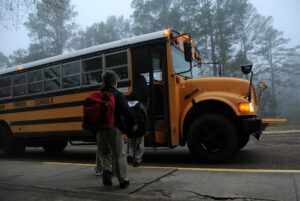Next Stop: Focusing on School Bus Drivers
By Jessie Tobin
More than one month into the 2021 – 2022 academic year, school personnel across the nation continue to grapple with pandemic-related challenges.
 One focus of attention is on the essential need to safely transport children and youth to school. The decision to use National Guard members to transport students to school amid bus driver shortages is making national headlines. Meanwhile media pundits are driving hot-button conversations about curriculum content. Videos of heated protests and debates during school board meetings are going viral across social media platforms. And discussions on the potential impacts of universal Pre-K and community college float through households amid Washington’s battle over the Reconciliation Package.
One focus of attention is on the essential need to safely transport children and youth to school. The decision to use National Guard members to transport students to school amid bus driver shortages is making national headlines. Meanwhile media pundits are driving hot-button conversations about curriculum content. Videos of heated protests and debates during school board meetings are going viral across social media platforms. And discussions on the potential impacts of universal Pre-K and community college float through households amid Washington’s battle over the Reconciliation Package.
Focusing on School Transportation
Although national attention on education could galvanize resources and will for positive change, it is critical that a variety of stakeholders including educators, parents, and community members come together to help make schools function during these extraordinary times.
To this point a number of research studies have indicated the essential need for community stakeholder voices to be included in identifying solutions to complex problems.
 Specifically focusing on the current challenges school and district leaders are facing with regard to transportation, an EdWeek column suggests that raising wages for bus drivers would help end the current shortage in drivers. And a national survey conducted by the National School Transportation Association revealed that pay was a major factor in recruiting drivers.
Specifically focusing on the current challenges school and district leaders are facing with regard to transportation, an EdWeek column suggests that raising wages for bus drivers would help end the current shortage in drivers. And a national survey conducted by the National School Transportation Association revealed that pay was a major factor in recruiting drivers.
Meanwhile, creative solutions such as eliminating barriers for bus driver licensing through the development and use of exams in different languages are popping up around the country.
NYKids Education Workforce Study on Differential Impacts of the Pandemic
As discussed in previous blogs, the NYKids research team launched a mixed-methods study to better understand educators’ personal and professional experiences during the 2020 – 2021 school year. Investigators surveyed teachers and support staff (e.g., counselors and social workers) and conducted one-on-one interviews with principals. These data provide insights into the issues leaders are facing with meeting a variety of challenges including:
- Educators in schools serving a higher percentage of children growing up in poverty reported a greater likelihood of leaving their professions since the start of the pandemic. This finding predicts continued and even growing workforce shortfalls in higher poverty school districts.
- Leaders in schools with the least likelihood of having frontline staff leave their jobs tended to draw on frontline educator input and connect with community resources relatively seamlessly. This finding recommends that leaders make listening to frontline educators’ voices a priority and make creative use of all available community resources to address worker shortfalls.
Stay tuned for our next blog diving further into the topic of school transportation, exploring the reasons behind why individuals remain in or leave this field, and breaking down implications for practice to continue to support school bus drivers in the future.
As always, we thank you for your interest in NYKids and encourage you to reach out to nykids@albany.edu for research-based school improvement resources.
Please visit our research results page for more information about our study, sign up for our newsletter, and connect with us on social media.
